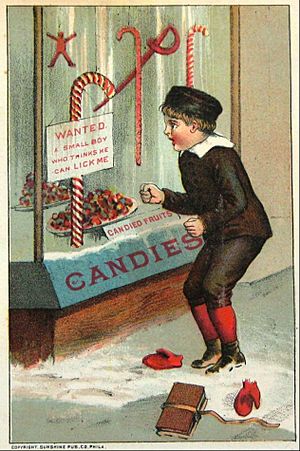Candy cane facts for kids

A traditional candy cane
|
|
| Alternative names | Peppermint stick |
|---|---|
| Type | Confectionery |
| Place of origin | Germany |
| Main ingredients | Sugar, flavoring (often peppermint) |
A candy cane is a sweet, cane-shaped candy. It's often seen around Christmastide (the Christmas season) and Saint Nicholas Day. Most candy canes are white with red stripes. They usually taste like peppermint. But you can find them in many other colors and flavors too!
Contents
History of Candy Canes
There's a popular story about how candy canes began. It says that in 1670, in Cologne, Germany, a choirmaster at the Cologne Cathedral had a problem. The children in his church were making too much noise during services.
He asked a local candy maker to create some "sugar sticks" for them. To make it okay to give candy in church, he asked for a special shape. He wanted the candy maker to add a hook, or "crook," to the top of each stick. This hook was meant to remind children of the shepherds who visited the infant Jesus.
The choirmaster also used the white color of the candy. He taught the children that the white color stood for the pure, sinless life of Jesus.
From Germany, these special candies spread across Europe. People gave them out during plays that showed the Christmas story. This is how the candy cane became linked to the Christmastide season.
How Candy Canes Are Made
In the past, candy canes were all made by hand. This took a lot of effort and time. Workers had to bend each cane by hand right after it was made to give it its curved shape. Many canes would break during this process.
In 1919, in Albany, Georgia, a man named Robert McCormack started making candy canes. He made them for children in his town. By the middle of the 1900s, his company became very successful. It was known as Bobs Candies later on. His company became one of the biggest candy cane makers in the world.
Later, machines were invented to help make candy canes. Gregory Harding Keller created the Keller Machine. This machine could twist soft candy into stripes and cut it into perfect candy cane lengths. This made it much easier to produce many candy canes quickly.
Fun Facts About Candy Canes
- The first time the words "candy cane" were written down was in a short story. It was called "Tom Luther's Stockings" and came out in 1866.
- In the early 1920s, a company in Chicago called Bunte Brothers got one of the first patents for machines that made candy canes.
- On Saint Nicholas Day, children sometimes receive candy canes. This is because the candy cane's shape can look like the crosier (a special staff) carried by a Christian bishop, like Saint Nicholas. The crosier reminds people of a shepherd's crook, which links to the idea of the Good Shepherd, a name sometimes used for Jesus.
Images for kids
See also
 In Spanish: Bastón de caramelo para niños
In Spanish: Bastón de caramelo para niños




